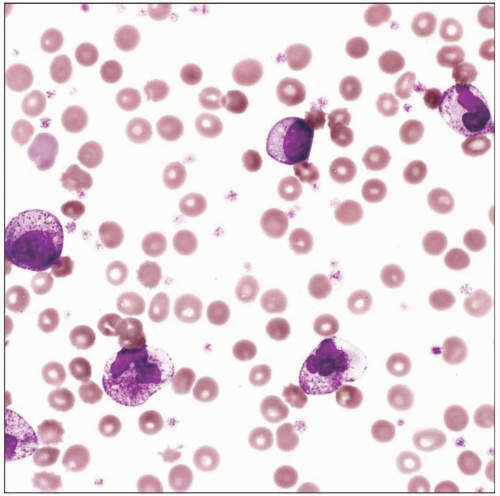Neutrophilia
Kathryn Foucar, MD
Key Facts
Terminology
Absolute neutrophil count (ANC) that exceeds age-related normal ranges
Newborn > 28.0 × 109/L
Infant > 10.0 × 109/L
Child > 8.0 × 109/L
Adult > 7.0 × 109/L
Etiology/Pathogenesis
Many causes of secondary neutrophilias
Infections most common
Other causes: Inflammation, metabolic disorders, medications
Rare constitutional neutrophilias
Pathogenesis
Demargination
Release of bone marrow reserve compartment
Increased neutrophil production in bone marrow
Microscopic Pathology
Absolute neutrophilia
Variable degree of left shift of neutrophil lineage
Toxic changes usually present
Other lineages generally unremarkable
Top Differential Diagnoses
Chronic myelogenous leukemia (CML)
Chronic neutrophilic leukemia (CNL)
Other myeloproliferative neoplasm
Diagnostic Checklist
Careful history for possible cytokine therapy
Consider myeloproliferative neoplasm
If splenomegaly or basophilia present
 Blood smear from a patient with rectal prolapse and acute bacterial infection is shown. Note toxic changes in the neutrophils. Anemia is also present, likely from chronic disease. |
TERMINOLOGY
Synonyms
Granulocytosis
Definitions
Absolute neutrophil count (ANC) that exceeds age-related normal ranges
Newborn > 28.0 × 109/L
Infant > 10.0 × 109/L
Child > 8.0 × 109/L
Adult > 7.0 × 109/L
ETIOLOGY/PATHOGENESIS
Diverse Etiologies for 2° Neutrophilias
Infections (usually bacteria)
Occasional viral infections (SARS, Hantavirus)
Medications/hormones/endogenous overproduction
Colony-stimulating factors
Chemokines
CSF/chemokine-producing neoplasms
Epinephrine
Corticosteroids
Lithium
Inflammatory and metabolic disorders
Burns, trauma
Infarction, gout
Collagen vascular disease
Ketoacidosis
Eclampsia
Other
Stress
Asphyxia
Pregnancy
Smoking
Toxins
Venoms
Constitutional Neutrophilic Disorders
Leukocyte adhesion deficiency (LAD)
Neutrophil production increased
Marked neutrophilia in blood
Neutrophils unable to migrate to sites of infection
Multiple genetic types
Hereditary neutrophilia
Familial cold urticaria
Pathophysiology
Astronomical daily production rates of neutrophils in bone marrow
Large reserve of neutrophils, bands, and neutrophilic myelocytes is present in central medullary regions of bone marrow
Reserve pool can be released into blood
Neutrophils circulate for only a few hours before migrating to tissue
Neutrophils migrate by attaching to endothelium and passing through vessel wall
ANC highest normal range at birth
Should decline rapidly after birth
Lymphocytes outnumber neutrophils by 1 week of age
Neutrophil homeostasis maintained largely via steady bone marrow production
Mechanisms of Neutrophilia
Demargination
Neutrophils attached to endothelium are released back into circulation
Caused by epinephrine
Rapid process
Doubles ANC within a few minutes
Release of bone marrow reserve compartment
Caused by corticosteroids and G-CSF
Takes several hours
Left shift in blood
Increased production
Stay updated, free articles. Join our Telegram channel

Full access? Get Clinical Tree



